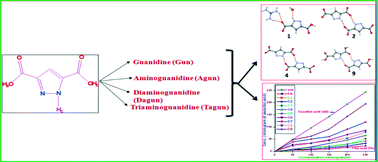Structural and anti-oxidant properties of guanidinium pyrazole-3,5-dicarboxylates†
Abstract
Multicomponent crystals (either salts or co-crystals) of pyrazole-3,5-dicarboxylic acid (H3pzdc) with the nitrogen-containing organic bases guanidine (Gun), aminoguanidine (Agun), diaminoguanidine (Dagun) and triaminoguanidine (Tagun) have been synthesized and characterized by IR spectroscopy, TG-DTA, and single-crystal X-ray diffraction. Aminoguanidine and diaminoguanidine exhibit three types of salts depending upon the reaction conditions, comprising (a) 1 : 1 salts [AgunH/DagunH][H2pzdc], (b) 2 : 1 salts generated by double deprotonation of the acid [AgunH/DagunH]2[Hpzdc], and (c) the unusual 1 : 2 salts [AgunH/DagunH][H2pzdc][H3pzdc], which comprise cocrystals of the 1 : 1 salt and the free acid. Interestingly, Tagun forms only the 1 : 2 salt [TagunH][H2pzdc][H3pzdc] irrespective of stoichiometry. The hydrogen-bonded assemblies associated with each structure are discussed. The co-crystals of free acid and the mono-deprotonated acid have melting points distinct from those of both the 1 : 1 and the 2 : 1 salts, consistent with phase pure materials. TG-DTA studies on these salts reveal that thermal degradation occurs through desolvation and loss of free organic base. Both the parent acid and its salts display a strong fluorescence emission (λem = 373–438 nm) at room temperature. Their antibacterial activity and total antioxidant capacity (TAC) as well as DPPH assays of the free acid and its salts are reported. The crucial role of the hydrazinic moiety in the antibacterial and antioxidant activities is identified.


 Please wait while we load your content...
Please wait while we load your content...